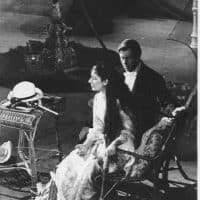I recently brought a group of friends to a production of Pietro-Andrea Ziani’s La Circe. (Side note: in the vanishingly unlikely event that this opera is performed near you, I highly recommend attending.) One of the characters, Egle, spends a good chunk of the opera disguised as a man following around her faithless ex-fiancé, Glauco. She even confronts him directly in one scene, saying that she met a girl who was lamenting the cruelty of the man who abandoned her (the Baroque equivalent of “asking for a friend”). Although Egle’s disguise consists only of putting up her hair and donning a mustache, Glauco never for a moment suspects her identity. One of my friends was baffled by this. “How can he not know it’s her?,” she kept asking. I could only shrug and answer, “It’s opera.”

Improbably effective disguises do seem to be a staple of the genre. The most famous—and egregious—examples are surely in Così fan tutte. You have to wonder if Fiordiligi and Dorabella are just a bit dense. They can’t see through their lovers’ disguises as Albanians (usually with nothing more than new clothes and mustaches). They also fail to recognize their own maid Despina, who arrives in two different guises (as a doctor in act one and a notary in act two). Elsewhere in the Mozart universe (La finta giardiniera), Count Belfiore is not quite so naive. He quickly recognizes the Marchioness Violante in the gardening girl “Sandrina”… but her refusal to doff her disguise convinces him that he was wrong. (Between his love for Violante and his guilt over having stabbed her, you’d think he’d be able to confidently identify her!)

And then there are the Handel operas. Disguise in Atalanta is absolute: Atalanta is shocked when King Meleagro has the love token she gave to “Tirsi” (that same king in disguise as a shepherd). Serse features more of the can’t-recognize-own-ex trope. The Wikipedia synopsis includes this wonderful description of Xerxes’ reaction to his ex-lover’s appearance: “When Amastre-in-disguise appears, Xerxes is calling out for someone to avenge him and wants to know what Amastre-in-disguise has been doing popping in and out of the entire opera…” Bradamante’s cover story in Alcina is more understandable. For one, she claims to be her brother Ricciardo, so she has a good excuse for her uncanny resemblance to herself. For another, the person who really ought to recognize her—her lover Ruggiero—is completely addled by Alcina’s magic.
Operettas feature a fair number of hidden identities as well. In J. Strauss’s Die Fledermaus, Eisenstein tries to seduce his own wife masquerading as a Hungarian countess, but we’ll forgive him because she’s masked and he’s probably drunk. At least he sees through his housemaid’s pretense at aristocratic lineage. In Offenbach’s La belle Hélène, Helen can’t see that the priest insisting she atone for her sins is actually her beloved Paris plotting a getaway for two. (Maybe the priestly garb is very concealing?)
Not all operatic disguises are absurd. Almaviva can become Lindoro, Leonore can become Fidelio, and Ramiro can switch jobs with Dandini precisely because no one they’re trying to fool knows what they look like. In the other cases, we just have to suspend disbelief and chalk it up to the magic power of opera!









